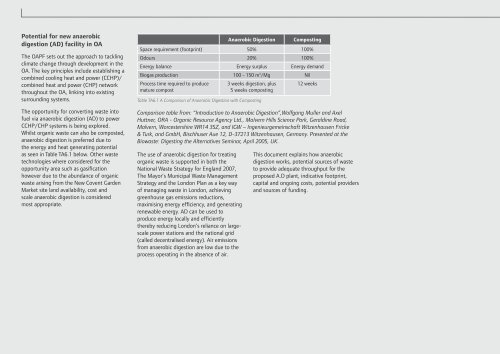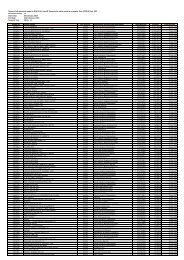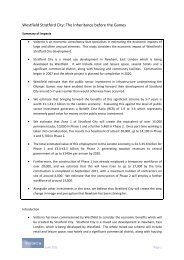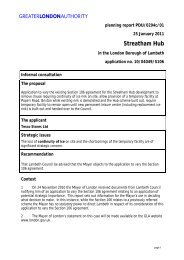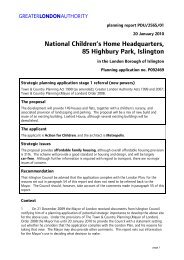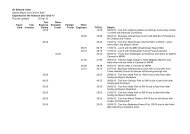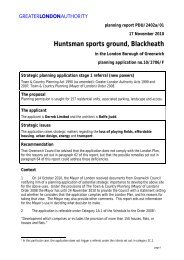320 <strong>Vauxhall</strong> <strong>Nine</strong> <strong>Elms</strong> <strong>Battersea</strong> <strong>Opportunity</strong> <strong>Area</strong> <strong>Planning</strong> <strong>Framework</strong>Potential for new anaerobicdigestion (AD) facility in OAThe OAPF sets out the approach to tacklingclimate change through development in theOA. The key principles include establishing acombined cooling heat and power (CCHP)/combined heat and power (CHP) networkthroughout the OA, linking into existingsurrounding systems.The opportunity for converting waste intofuel via anaerobic digestion (AD) to powerCCHP/CHP systems is being explored.Whilst organic waste can also be composted,anaerobic digestion is preferred due tothe energy and heat generating potentialas seen in Table TA6.1 below. Other wastetechnologies where considered for theopportunity area such as gasificationhowever due to the abundance of organicwaste arising from the New Covent GardenMarket site land availability, cost andscale anaerobic digestion is consideredmost appropriate.Anaerobic DigestionCompostingSpace requirement (footprint) 50% 100%Odours 20% 100%Energy balance Energy surplus Energy demandBiogas production 100 - 150 m 3 /Mg NilProcess time required to producemature compost3 weeks digestion, plus5 weeks composting12 weeksTable TA6.1 A Comparison of Anaerobic Digestion with CompostingComparison table from: “Introduction to Anaerobic Digestion”,Wolfgang Muller and AxelHuttner, ORA - Organic Resource Agency Ltd., Malvern Hills Science Park, Geraldine Road,Malvern, Worcestershire WR14 3SZ, and IGW – Ingenieurgemeinschaft Witzenhausen Fricke& Turk, and GmbH, Bischhuser Aue 12, D-37213 Witzenhausen, Germany. Presented at theBiowaste: Digesting the Alternatives Seminar, April 2005, UK.The use of anaerobic digestion for treatingorganic waste is supported in both theNational Waste Strategy for England 2007,The Mayor’s Municipal Waste ManagementStrategy and the London Plan as a key wayof managing waste in London, achievinggreenhouse gas emissions reductions,maximising energy efficiency, and generatingrenewable energy. AD can be used toproduce energy locally and efficientlythereby reducing London’s reliance on largescalepower stations and the national grid(called decentralised energy). Air emissionsfrom anaerobic digestion are low due to theprocess operating in the absence of air.This document explains how anaerobicdigestion works, potential sources of wasteto provide adequate throughput for theproposed A.D plant, indicative footprint,capital and ongoing costs, potential providersand sources of funding.
<strong>Vauxhall</strong> <strong>Nine</strong> <strong>Elms</strong> <strong>Battersea</strong> <strong>Opportunity</strong> <strong>Area</strong> <strong>Planning</strong> <strong>Framework</strong>TA 06 Waste and wharves strategyMayor of London321How does AD work?AD is a complex bio-chemical process thattakes place in a vessel in the absence ofoxygen and results mainly in the formationof a carbon dioxide and methane gas mixtureknown as “Biogas” and a solid and liquidresidue (the liquid may be reused in someprocesses). Source segregated organic wasteis preferred for most AD systems howeverwhere this is not available then mechanicalprocessing and separation of municipal wasteis essential to remove non-biodegradablematerials prior to processing. A typicalfeedstock comprises biodegradable municipalsolid wastes (BMW) plus other enrichedorganic waste streams (sewage sludge,agricultural, food processing wastes).Source: Enviro control website, schematic showing an anaerobic digestion systemhttp://www.enviro-control.co.uk/waste/technology/schematic.htm, last accessed 09/04/09.WRWA – Hammersmith and Fulham, Lambeth, Kensington and Chelsea and WandsworthOther CAZ boroughs - City, TH, Westminster, Southwark,The organic waste stream is passed tothe anaerobic digester where the materialremains for a suitable retention time undercontrolled conditions. The “Biogas” producedduring digestion is transferred to a gasholderand used to provide internal electrical powergeneration and heating requirements. Surpluselectrical power may be sold which is eligiblefor Renewables Obligation Certificates. Seeschematic on anaerobic digestion below:Potential waste sources forproposed AD plantTable TA6.2 below identifies LondonBoroughs within close proximity that couldpotentially provide organic waste feedstockfor the proposed AD facility. These includeWestern riverside boroughs 7 , boroughs in thecentral activity zone 8 as well and Richmond.Other sources of organic waste feedstockinclude the New Covent Garden market aswell as waste from the proposed 16,750 newresidential units.It should be noted that of the boroughsidentified Lambeth, the City of Londonand Westminster are currently runningsmall scale food waste collections only. TheLondon borough of Richmond is the onlylocal authority listed to offer a borough-widefood waste scheme. Some of the boroughsidentified have suggested that one of thereasons they do not offer organic collectionsis because there is no existing facility inLondon to take it. The proposed AD plantmay therefore provide an incentive for theboroughs identified to introduce boroughwideschemes, which could be processed atthe proposed plant subject to contractualarrangements.CGMA should however be aware that otherproposals for AD facilities in the boroughsidentified could come forward given thepotential access to grant funding from theLondon Waste and Recycling Board. If thiswere to happen, this could potentially createcompetition for waste throughput suggestedfor the proposed AD facility.Current waste arrangements inboroughs identifiedThe New Covent Garden Market is located inWandsworth, which falls within the WesternRiverside Waste Authority (WRWA). WRWAis the statutory body responsible for thedisposal of household, commercial andindustrial waste delivered to it by the LondonBoroughs of Hammersmith and Fulham,Lambeth, Wandsworth and the RoyalBorough of Kensington and Chelsea. It alsooperates two waste transfer stations situatedon the River Thames in South London, one inWandsworth and the other in <strong>Battersea</strong> andruns the civic amenity sites (or public tips) atboth these sites, which may also be used byresidents of the City of Westminster.The remaining boroughs with the exceptionof the London Borough of Richmond areunitary waste authorities responsible forboth the collection and disposal of its ownwaste. The London Borough of Richmondis responsible for the collection of its ownwaste but belong to West London WasteAuthority, which is responsible for the disposalof the West London boroughs 9 waste.Existing waste contractsEach borough have existing waste collectionand disposal contracts in place whichcould potentially affect whether or notthe suggested boroughs are able to taketheir organic waste to the proposed facility.Contract details are summarized below:7WRWA – Hammersmith and Fulham, Lambeth,Kensington and Chelsea and Wandsworth8Other CAZ boroughs - City, TH, Westminster, Southwark,9WLWA boroughs includes - Brent, Ealing, Harrow,Hillingdon, Hounslow and Richmond-upon-Thames


